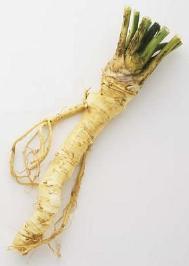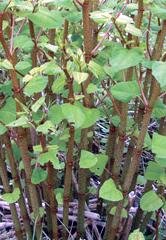
My uncle Bill lives in Manhattan, but had a house in Tannersville, New York, to allow him to escape to the mountains on weekends. He wanted to create a garden there, as there's not a lot of arable land available in Manhattan. As it turned out, the soil wasn't very good in Tannersville, either, being mostly rock. But good garden soil can be purchased. So Bill had a truckload of loam delivered, and dumped into a shallow depression in the rock, where he created a vegetable garden. Among the things that he wanted to grow, he counted horseradish, a fiery root that can be ground up and used to adorn all sorts of foods. He knew enough, though, to not plant it in his small garden plot. Horseradish grows like a weed, putting out runners and spreading wildly. Bill had gone to too much trouble and expense creating his garden to let it become overrun with horseradish. He therefore filled a large wooden barrel with potting soil, and planted the horseradish in that. Thus, although the barrel was outdoors, alongside the garden, the horseradish was kept apart. This worked fine for a year or two. But then one year, horseradish appeared all around the base of the barrel. Horrified, Bill broke the barrel open to see what had happened, and found that the plant had sent a long tap root down about a meter, to the bottom of the barrel. There, it had penetrated the rotted-out wood at the bottom, and then branched sideways into the garden soil. The beast was loose - within a year or two, the garden would be all horseradish. The demon horseradish had triumphed. Bill was forced to bring in another truckload of soil, to create a completely new garden in another location. Somewhere along the way, Bill gave us newlyweds a large horseradish root (he had a lot of it). We were thrilled, and to prepare it for grinding up, I peeled it with a potato peeler, and threw the peels into our "disposal", to be ground up and washed down the drain. This operation instantly clogged the sink. I removed the drain plug in the trap to see what was going on, and found it densely packed with chopped horseradish. Apparently, after the disposal chopped up the peels, the fragments had absorbed water, and instantly swelled to many times their original size, immediately clogging the drain. I had to take apart the trap, and remove the clog with a long spoon. After grinding up the rest of the demon horseradish, we then determined to find something good to put it on. It's very good on roast beef, but it happened to be around the time of Passover, a Jewish holiday that celebrates the exodus from Egypt. Horseradish is usually used in the traditional Passover meal, called a Seder. But it is also used as a condiment on a traditional dish called "gefilte fish", frequently a part of the festival meal, and that's what we set out to buy. We lived, at the time, in Watertown, Massachusetts, and I drove off to a local supermarket.
And it was equally unavailable in the third market, but there the manager knew a bit more about it. "I love Watertown", he said, "it's a great community. Did you know that it has the largest Armenian population of any city in the United States? But you won't find gefilte fish here. Try Newton." So I got back into the car, drove over the Watertown border into the city of Newton, Massachusetts, which, unlike Watertown, has a large Jewish population. It was a drive of only a mile or so, and I stopped at the first supermarket I saw after crossing the town line. Just inside the entrance I found a massive, floor-to-ceiling display of Passover goods, including about fifteen different kinds of gefilte fish. With our freshly ground horseradish, it was delicious. I have one more horseradish story, although it's second-hand. My friend and college classmate Martin Schrage once worked for the Boston area high-tech company EG&G, named for its MIT founders Edgerton, Germeshausen, and Grier. Among other things, EG&G was contracted to do high-speed measurements during atomic bomb tests. I recall being briefly interviewed by the Feds when Martin applied for the security clearance needed to do this work (and they also interviewed any ex-girlfriends they could find). Some of the work was conducted in Los Alamos, New Mexico. Because there is not much to do there, employees were reimbursed for short commercial plane flights to Albuquerque. Martin had a friend in Albuquerque who was of Mexican descent, and an aficionado of the very spicy Mexican dishes often served there. These were frequently seasoned with chili peppers, of the sort which, if you simply touched them to your lips, left you in agony for about an hour. Martin's friend, however, used to eat these things in vast quantities - perhaps they had fried off his taste buds years earlier. On one visit, Martin noticed that a Jewish restaurant, of all things, had opened in Albuquerque. He decided to give this a try, and took his friend there. As the meal was served, a dish of freshly-ground horseradish was set down on the table. "What's that?", asked his friend. "I'll bet you'll love it", Martin said, "since you really like hot stuff". The friend spooned a generous dollop onto his gefilte fish (or whatever they were eating), and took a bite. Suddenly his face turned scarlet, he stood up, and started running around the room, gasping for air. The "heat" of horseradish, it turns out, is nothing at all like the "heat" of jalapeño peppers. As killer hot as they can be, peppers only burn what they touch, usually your mouth and tongue. But horseradish, in addition to doing that (to a much lesser degree than the peppers), also generates fumes that rise into your throat and nose. Martin's friend didn't know the trick of breathing in through his nose and out through his mouth, and so became unable to breath without inhaling horseradish vapor.
Bamboo itself is pretty invasive. We wanted to plant some when we did some landscaping a while back, but the landscape architect advised against it. He says he's seen bamboo sit quietly for a few years, only to have it suddenly pop up on the other side of the lawn.   Note 1: The German verb meaning "to fill" is füllen, and thus its past participle, meaning "filled" or "stuffed" is gefüllte. The Jewish language Yiddish is related to German, but that u-umlaut ("ü") sound generally changes to a short "i" in Yiddish. For that matter, it becomes a short "i" in English, a Germanic language. German füllen and English "fill" are cognates. [return to text]  |
 Can I really have enough stories about horseradish for an entry in my memoirs? Apparently so.
Can I really have enough stories about horseradish for an entry in my memoirs? Apparently so.
 Gefilte fish is made of chopped fish, often whitefish or pike. It's generally sold in jars, as shown to the
right.
Gefilte fish is made of chopped fish, often whitefish or pike. It's generally sold in jars, as shown to the
right. 
 There are many other invasive plants. The southern US is overrun by kudzu (shown to the left), a fast-growing vine that can cover trees, telephone poles, cars, and even houses. Here in New England, our roadsides are infested with
There are many other invasive plants. The southern US is overrun by kudzu (shown to the left), a fast-growing vine that can cover trees, telephone poles, cars, and even houses. Here in New England, our roadsides are infested with